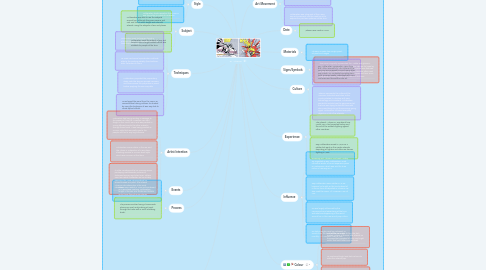8A - Whamm!
by Renee Brown

1. Material
1.1. Whaam! is made from materials such as acrylic paint, oil paint and magna
1.2. canvas
2. Style
2.1. He copied the mechanical reproduction methods of the printing industry (Hard outlines, dots, flat areas of colour)
2.2. Lichtenstein took inspiration from comics and their style to create his artworks.
3. Subject
3.1. Lichtenstein was able to use the subjects around him, although they were serious and sad, and turn it into a bright and colourful artwork, using the subjects of war and planes
3.2. Lichtenstein used the subject of war and turned it into a bright artwork which was relatable to people at the time.
4. Techniques
4.1. Lichtenstein used techniques found in old-style comics and newspapers which he took inspiration from.
4.2. He used mechanical reproduction methods alike to the printing industry (hard outlines, dots, flat areas of colour
4.3. Lichtenstein projected the preparatory study onto the two pre-primed canvases and drew around the projection in pencil before applying the Ben-Day dots
4.4. He enlarged the panel from the comic on canvas before tracing outlines, he shaded by using the technique of Ben Day dots to create optical effects.
5. Artist Intention
5.1. Lichenstein had being sending a message to the viewers of how the American men had fought in the World War 2 and was painted in a very different way to the other artworks through those times. It was being painted as a comic style that was really new to the people and had a very big influence.
5.2. Lichtenstein was a soldier in the war and the Wham is a depiction of a war plane shooting missiles in a comic book style which was common at that time.
5.3. It is the counterpoint to his romance series portraying melodramatic pictures of distressed women and silent men. Others see it as a what if reflection on his military service in the 1940's during which he almost trained as a pilot. The artwork Whamm! also shows him at his most rebellious.
6. Events
6.1. Wham was created in 1963 and was based on a war plane crashing. Lichtenstein fought in the war as a soldier and looked up to those flying the war planes.
7. Process
7.1. The process involved using a homemade aluminium mesh and pushing oil paint through the holes with a small scrubbing brush.
8. Composition
8.1. a large, two-canvas painting by the American pop artist Roy Lichtenstein that takes its composition from a comic book strip.
9. Signs/Symbols
9.1. This comic originally represented the "noble and glorious" ideas of war, and Liechtenstein turned this idea on it's head by poking fun at the fact that such a serious symbol was featured in the form of a colourful comic book. Lichtenstein often used his art to laugh at masculinity, war, stereotypes and love, since they were common tropes in the media at that time
10. Art Movement
10.1. Lichtenstein and his art work are largely recognized for moving what was considered to be art from a period of realism and into a new movement of pop art
10.2. Lichtenstein was a big part of the 1950s Pop art movement, and he used his art to express the post-war optimism at the time.
11. Date
11.1. Whaam! was made in 1963
12. Materials
12.1. Whaam! is made from acrylic paint, oil paint and magna
13. Culture
13.1. Roy Lichtenstein's inspiration came from the culture around him. The culture of the 50's and 60's inspired him and many other pop artists. He contrasted everyday items such as comic books, advertisement, cans and more and turned this into art.
13.2. Whaam! represents the culture of the American industrial revolution as the country started to develop with new technology and inventions. Lichtenstein wanted to include how the government at the time was trying to distract them with shiny new things to get the economy going again. Lichtenstein included everyday objects in a lot of his artworks.
14. Experience
14.1. The artwork "Whamm!" was about how World War 2 had impacted history and the act of the soldiers fighting against other countries.
14.2. Roy Lichtenstein served in WW2 as a soldier but went on the create artworks depicting jet fighters and other war heroes fighting in Wars
15. Influence
15.1. Drowning Girl, Whaam!, and Look Mickey are regarded as Roy Lichtenstein's most influential works. His most expensive piece is Masterpiece, which was sold for $165 million in January 2017.
15.2. Roy Lichtenstein was a soldier in WW2, however he fought on the land instead of in the air force as depicted in Whamm! He also used the comic 'All-American Men of War'.
15.3. He was largely influenced by the commercials and advertising at the time and what was happening in the world around him in this new era of pop culture
15.4. He took a single panel by cartoonist Irv Novick from the issue of the DC comic monthly "All American Men of War"
16. Colour
16.1. Lichtenstein was able to turn the dark shaded colours of the war into artwork on the page that consisted of only very bright colour and bold letters and pictures.
16.2. He combined bright and dark colours to make the artwork pop.
16.3. Used bright colours, dark dots to make certain parts, (eg. text, key signs) stand out
16.4. Used primary colours such as red, blue, yellow and some secondary colours such as green


